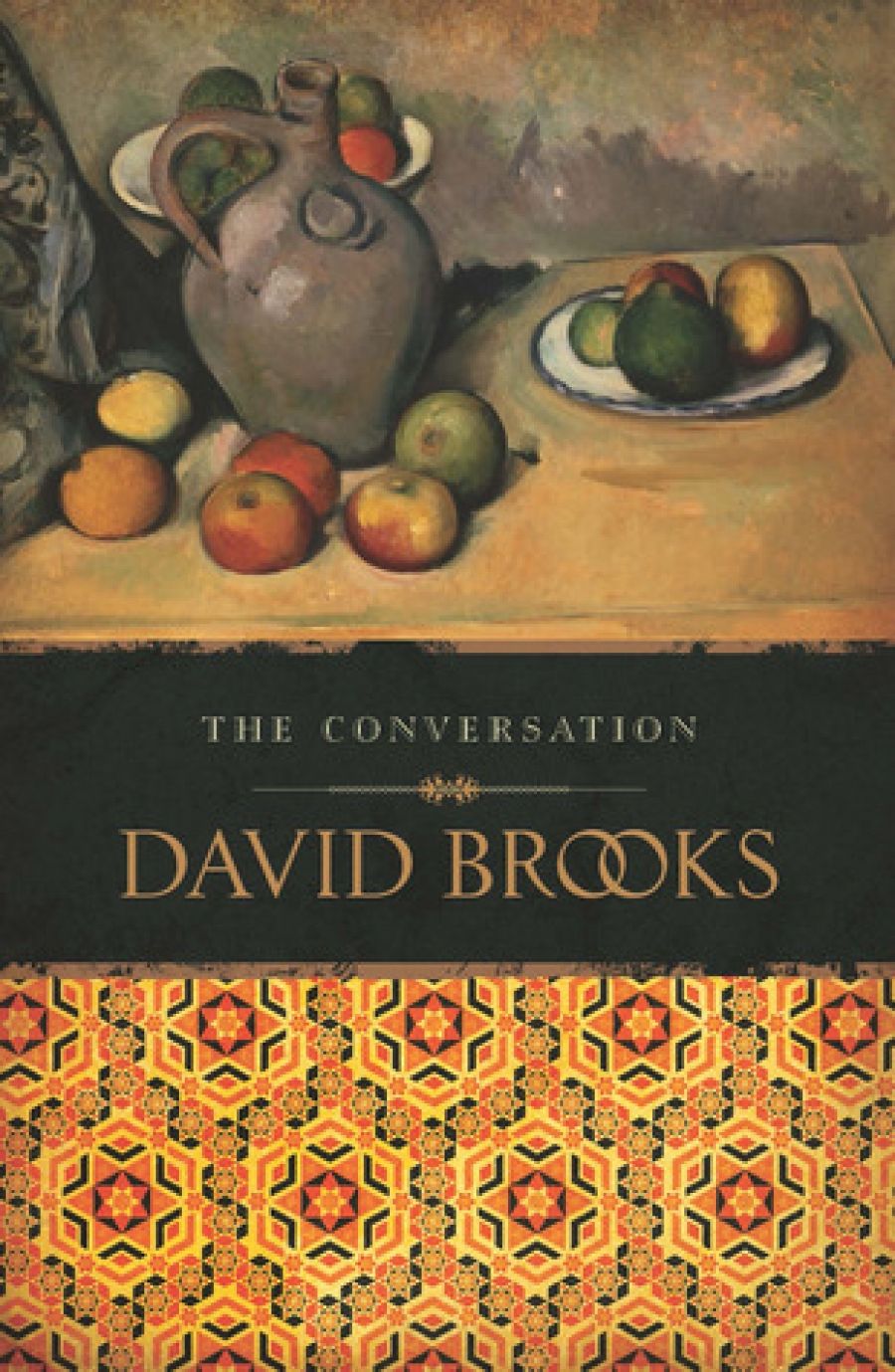
- Free Article: No
- Contents Category: Fiction
- Review Article: Yes
- Online Only: No
- Custom Highlight Text:
The epigraph from Plato’s Phaedrus cleverly introduces the Socratic dialogue on which David Brooks’s new novel turns. This makes for a brilliant foray into the contradictions at the heart of the truths that both characters are seeking in The Conversation. This question-and-answer exchange is presented as a kind of Scheherazadian dégustation of narratives, where the novel endures for as long as the stories continue. For this reason, the emphasis is on pauses, languor, and an understanding of the way in which something can consume (‘eat away at’) a person.
- Book 1 Title: The Conversation
- Book 1 Biblio: University of Queensland Press, $29.95 hb, 240 pp, 9780702249440
This novel is about ‘walking outside the wall’. Australian expatriate Stephen Mitchell has for more than twenty years been living in Paris with his third wife, in a kind of self-imposed exile. ‘Listless’ on business in Monfalcone, Italy, Stephen catches a taxi to Trieste. His journey is chronicled in one of the most dextrous descriptions in the novel, in which Brooks revives the dying art of the extended sentence.
It is this brilliant control of language that identifies Brooks as one of Australia’s finest writers. He is an accomplished novelist, poet, and essayist, as well as lecturer in Australian Literature at the University of Sydney. The Conversation is his fourth novel and the third published by the University of Queensland Press; The Fern Tattoo was shortlisted for the Miles Franklin Literary Award in 2008.
The Conversation is divided into three sections, foregrounding place. Bookended by ‘Cornische’ and ‘Molo’, the bulk of the narrative takes place in the middle section, entitled ‘Caffé Cosini’, the name of the restaurant in the Piazza Unitá where Stephen decides to have dinner. Within this section, the chapters become a series of courses – Antipasto, Primo Piatto, Insalata, Formaggi, Dolce – which mirror aspects of the eponymous conversation and the slow burn of the novel. This comes in the form of Irena Rizzoli, who suddenly appears, as if Stephen has conjured her in his imagination. She sits at a table opposite him and, when an unlikely storm upsets his table, engages him in conversation. She is reading A.S. Byatt’s Possession (1990), a recurring intertext in Brooks’s novel. When Irena questions the ‘artist’s use of the female muse’, Brooks is self-reflexively indicating that, without Irena, the novel cannot progress; since the conversation begins and ends with her, she is its muse.
In a double devouring, the characters consume food and wine while they simultaneously devour each other’s philosophical questions and dilemmas. Stephen orders zucchini flowers; when they arrive he ‘marvel[s] at [them] – golden yellow, veined with green, caught, as if in some ethereal amber, in a batter so thin it might have been called a glaze’. The amber suggests the importance of the moment: he will remember this night long after it is over; he will preserve it. The male zucchini flowers are veined phalluses that have been held by the stalk, dipped in mixture, and turned in oil until they froth and are finally drained. Irena tells Stephen that they have been treated respectfully. In this way, the protagonists are evenly matched and respectful of each other. The conversation becomes intensely personal. They eat and discuss what is ‘eating’ them. They consume food and wine and yet they are consumed by unanswerable questions: ‘I have been trying to sort out a problem and getting nowhere.’ The food ebbs and flows like sex: ‘You are eating one another almost, tasting, smelling, entering with fingers, tongues, minds, with your memory, with your hopes, with your appetite, as if you are both, together, the one creature, the one being that is seeking itself, but will also never be satisfied until it has swallowed itself somehow.’
In the tradition of literary classics that take place solely on one day, the plot is minimalist and the protagonists’ limited time together is always on their minds. The verbal play, and the conversation’s resolutions and impasses, provide the action as Stephen takes the role of teacher, only to find at various points that he is more of a student in his understanding of passion and women. As strangers (Brooks rarely uses their names) they reveal more than they normally would, defining the unique situation as a ‘field of potential’. In this way it is reminiscent of Richard Linklater’s films Before Sunrise (1995) and Before Sunset (2004), with their exciting verbal play, wit, and dialogue.
Australian writers are often rewarded for setting their novels in Australia and for using descriptions of flora and fauna as a backdrop to the narrative. It is a testament to Brooks that, though The Conversation is not set in Australia, it is a very Australian novel in the way it investigates the life of an expatriate and juxtaposes food, culture, personalities, and experiences. Occasionally, the more obvious references to Australia seem jarring: for instance, when Irena asks Stephen why he would move to a place like Paris when he lived in Australia. Here, though, Brooks is making an important point about the ‘cultural cringe’.
As I read this masterful book, I found myself hoping that Caffé Cosini would remain open all day so that the characters could order another ten courses and continue their dialogue. This is a book to savour, like the bottle of Lacryma Christi that the characters share.


Comments powered by CComment